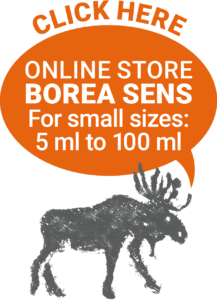BLACK SPRUCE bark Essential Oil

Latin name: Picea mariana
French Name: Épinette Noire
English Name: Black Spruce
Botanical family: Abietaceae or Pinaceae
Origin: Canada
Harvest time: January to December
Distilled Part: Wood & bark
Organoleptic Properties: Woody
Components: α-pinene, β-pinene , δ3-carene camphene, bornyl acetate
Materials and methods: Essential oil is extracted through a process of steam distillation. The bark is collected from the Picea mariana throughout the year in the region of Eeyou Istchee James Bay.
ORIGIN
Black Spruce is a majestic conifer ranging in height from of 8 to 25 meters. These trees look after our Canadian forests from coast to coast, because this conifer grows where other species cannot grow. Favoring moist, sandy or peaty soils, this tree covers North America mainly from Canada’s Far North to the edge of the low Arctic tundra, as well as the northeastern United States. Its twigs are rough and its frayed bark is reddish brown when young and darker when mature. Its greyish-green needles are straight and tight along its branches. Its fruit is a small purple cone that changes to light brown. Of the forty varieties of spruce, it is the most resistant to very cold climates. It can withstand up to -60 degree Celsius temperatures according to some studies. Without its biggest enemy, which is fire, this tree could live up to 280 years.
HISTORY
Native people have been using many medicinal plants from the boreal forest for thousands of years for healing purposes. This knowledge is generally held as a form of oral tradition. Cree from the woodlands used Black Spruce as an anti-diarrheal medication by making infusions from the cones. At other times the needles and cones were used to treat diabetes. For burns, they made balms from Black Spruce resin and chewed on cones to relieve toothache.
The Montagnais First Nations from the Quebec Province used Black Spruce to prepare infusions against sore throats and to cure coughs. Native American children chewed the resin to improve the whiteness of their teeth. They attributed to Black Spruce powerful properties against scurvy. Used mainly to build settlers’ homes, the tree was also used to brew spruce beer made from: needles, cones and molasses. Under the pretext of preventing scurvy, this drink flowed freely in the evenings with the clergyand on board ships!
In 1772, the English physician, Henry Taylor, discovered a method to extract the essential oil from the spruce and recommended it for respiratory diseases. Dr. Taylor is also the founder of the first distillery in Québec City.
Contraindications: None known under normal physiological doses.
Recommendation: Essential oils are wonderful for the well-being of humans, animals, insects and plants. There are many books that discuss aromatherapy and you should refer to them for proper and safe use. We also recommend that you consult a professional in aromatherapy who will be able to target the biochemical groups and aromatic molecules of essential oils and thus increase the effectiveness of your care.
Essential oils should be stored in a cool, dry place, protected from light and air.
The information provided on this website is NOT a recommendation of a cure or the treatment of a medical condition or disease.
References
- Frère Marie-Victorin, Rouleau Ernest, Brouillet Luc et collaborateurs, Flore laurentienne 3e édition, Gaëtan Morin Éditeur ltée, 2002.
- Moerman Daniel E., Native American Ethnobotany, Timber Press, Portland, Oregon, 1998.

